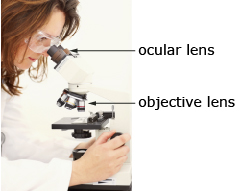Section 2
1. Section 2
1.38. Explore 2
Section 2: Perspective and Scale
Self-Check 1
- A map is drawn to a scale of 1:250 000. How many miles does 1 in on the map represent? Remember, there are 5280 ft in a mile. Round your answer to the nearest tenth of a mile. Answer
There are instances when a drawing or model is larger than the original. This is called a magnification. Microscope images, pictures, and diagrams are examples. When magnifying, the scale is greater than 1. For example, if the width of a scale drawing is 40 times the original, the scale would be 40:1 or ![]() .
.

Hemera/Thinkstock
Example
An amoeba is a tiny, one-celled organism frequently studied by biologists. You need a microscope to see most amoebas: the largest are only about 1 mm across. If an amoeba measuring 0.32 mm is observed through a microscope at 40x magnification, what size will its magnified image be?
If you are interested in learning more about amoebas, watch the video “Inside an Amoeba.”
Solution
|
→ | 40:1 = magnified image size:actual object size |
|
→ |  |
|
→ |  |
The size of the amoeba through the microscope would be 12.8 mm.
